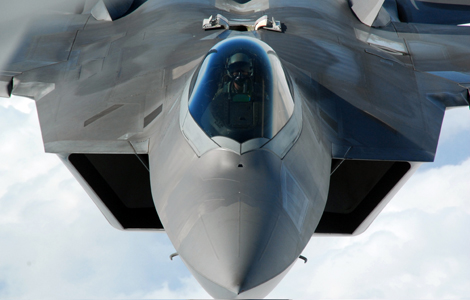Raptor in the Doghouse
The Air Force’s most sophisticated fighter, the F-22, has a problem with its oxygen system, and increasingly, with its image.
Early May was not a good time to be a public affairs officer for the F-22 Raptor. Both ABC and CBS investigated the airplane’s troubles with a system that provides enriched oxygen to the pilot at high altitude. A CBS “60 Minutes” segment extensively interviewed two Air Force pilots who went public with their decisions to refuse to fly any more missions in the F-22, which is not currently engaged in combat.
The pilots say they have experienced symptoms that appear to indicate hypoxia, or a lack of oxygen that occurs at high altitude. One told the CBS interviewer that he recognized the early onset of hypoxia but became so hampered by his lack of ability to focus that he was unable to recall where the control was to activate the emergency oxygen supply.
Older aircraft supply oxygen to the crew from pressurized tanks, which are heavy and can explode if struck by a projectile. With newer aircraft like the F-22, the Air Force has been moving to systems based on a molecular sieve principle, in which nitrogen can be separated from ambient air by forcing it under pressure to adsorb onto a substance to which the nitrogen adheres, thereby providing air that is higher in oxygen content. So far, it’s not clear whether the system employed by the F-22 has a fundamental design problem, or if the airflow from the system is being contaminated somehow.
Air Force flight surgeons suggested that pilots wear sensors that clip onto one fingertip and read body oxygenation levels; the devices are familiar to hospital patients whose vital signs are monitored continually by automatic machines. But if contamination rather than an actual lack of oxygen is causing the symptoms of hypoxia, such sensors would not help. Charcoal filters were installed to cleanse the pilots’ airflow of any possible contaminants, but the filters only added to the problem when pilots began inhaling black dust from the charcoal.
So far, one pilot’s death in a Raptor crash is being blamed on the suspect oxygen system. Pilots are especially wary because hypoxia has bewildering symptoms, among which is a sudden feeling of elation. Its onset may reduce a pilot to a conscious but dysfunctional state within one or two minutes, and all military air crew members are trained in chambers that simulate oxygen deprivation at high altitude by pumping the air out while trainees try to write words or recognize pictures of common objects.
As a result of the controversy, the utility of the F-22 itself is being questioned, mostly due to its sophistication and cost. Reports say that one flight hour in one of the fighters costs the Air Force north of $40,000. And critics say the Raptor was designed to fight a foe that doesn’t exist. Interestingly, the two pilots interviewed by CBS both praise the airplane and love to fly it. But it’s hard to love anything when you’re starting to pass out.
You can watch the “60 Minutes” segment below:
